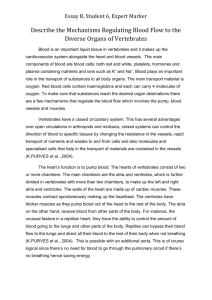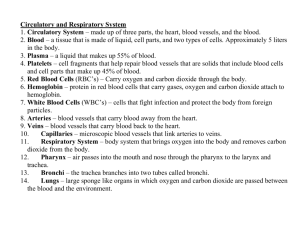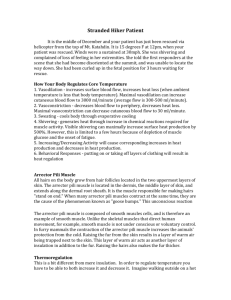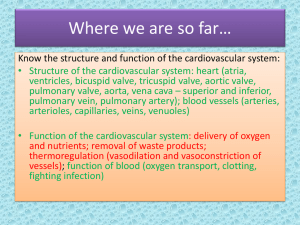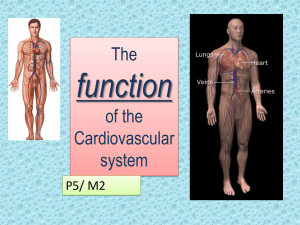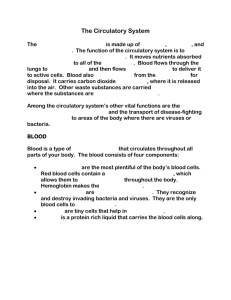Click here for notes
advertisement
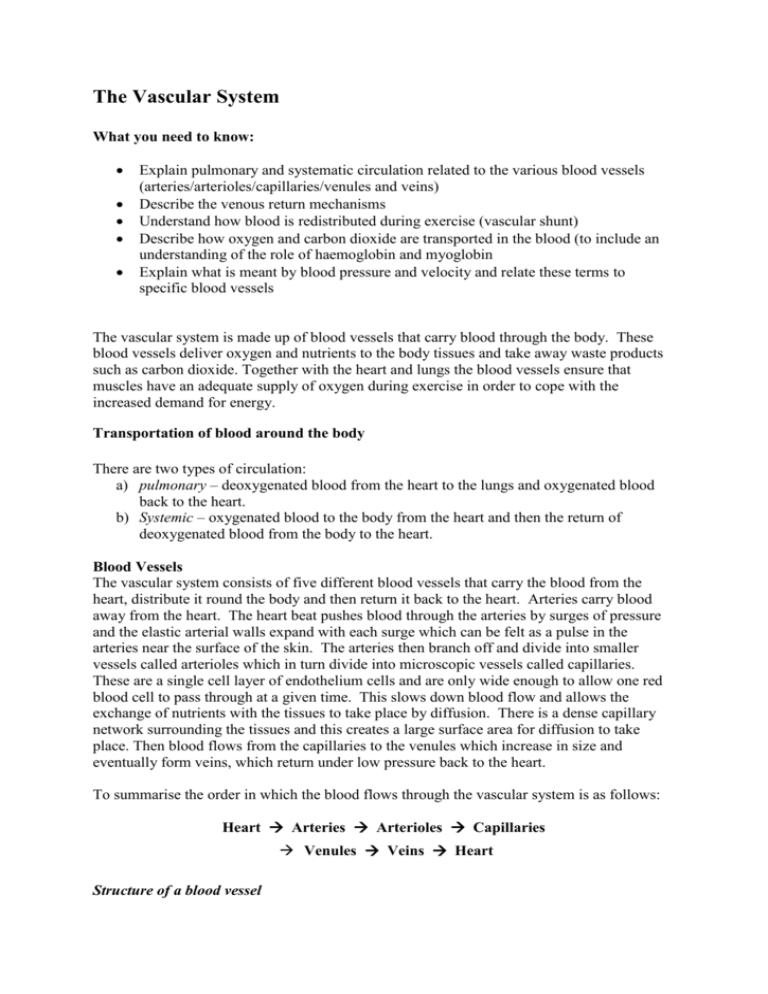
The Vascular System What you need to know: Explain pulmonary and systematic circulation related to the various blood vessels (arteries/arterioles/capillaries/venules and veins) Describe the venous return mechanisms Understand how blood is redistributed during exercise (vascular shunt) Describe how oxygen and carbon dioxide are transported in the blood (to include an understanding of the role of haemoglobin and myoglobin Explain what is meant by blood pressure and velocity and relate these terms to specific blood vessels The vascular system is made up of blood vessels that carry blood through the body. These blood vessels deliver oxygen and nutrients to the body tissues and take away waste products such as carbon dioxide. Together with the heart and lungs the blood vessels ensure that muscles have an adequate supply of oxygen during exercise in order to cope with the increased demand for energy. Transportation of blood around the body There are two types of circulation: a) pulmonary – deoxygenated blood from the heart to the lungs and oxygenated blood back to the heart. b) Systemic – oxygenated blood to the body from the heart and then the return of deoxygenated blood from the body to the heart. Blood Vessels The vascular system consists of five different blood vessels that carry the blood from the heart, distribute it round the body and then return it back to the heart. Arteries carry blood away from the heart. The heart beat pushes blood through the arteries by surges of pressure and the elastic arterial walls expand with each surge which can be felt as a pulse in the arteries near the surface of the skin. The arteries then branch off and divide into smaller vessels called arterioles which in turn divide into microscopic vessels called capillaries. These are a single cell layer of endothelium cells and are only wide enough to allow one red blood cell to pass through at a given time. This slows down blood flow and allows the exchange of nutrients with the tissues to take place by diffusion. There is a dense capillary network surrounding the tissues and this creates a large surface area for diffusion to take place. Then blood flows from the capillaries to the venules which increase in size and eventually form veins, which return under low pressure back to the heart. To summarise the order in which the blood flows through the vascular system is as follows: Heart Arteries Arterioles Capillaries Venules Veins Heart Structure of a blood vessel Arteries, arteriole, venules and veins all have a similar structure. Their walls consist of three layers: 1. Tunica externa (adventitia) – this is the outer layer which contains collagen fibres. This wall needs to be elastic in order to stretch and withstand large fluctuations in blood volume. 2. Tunica media – this is the middle layer which is made up of elastic fibres and smooth muscle. The elastic fibres are there to stretch when blood is forced into the arteries during ventricular systole. When they recoil they smooth out the flow of blood and push it along the arteries. The smooth muscle can contract in the walls of the smaller arteries and arterioles which ensures that the amount of blood flowing to various organs can vary according to different demands. 3. Tunica interna – this is made up of thin epithelial cells that are smooth and reduce friction between the blood and the vessel walls. All blood vessels have features that adapt them to their particular functions. These are summarised in the table below: Feature Artery Capillary Vein Tunica externa Present Absent Present Absent (middle layer) Thick with many elastic fibres Thinner and less elastic than in an artery Tunica interna Present Present Present Size of lumen Small Microscopic Large Valves Absent Absent Present (outer layer) Tunica media (inner layer) Artery Arteriole Thick wall and narrow lumen. Thinner wall, but relatively more muscle. Capillary Vein Microscopic vessels, wall one cell thick Valves, thin wall, little muscle, large lumen The Venous Return Mechanism Venous return is the return of blood back to the right side of the heart via the vena cava. Up to 70% of the total volume of blood is contained in the veins at rest. This means that a large amount of blood can be returned to the heart when needed. During exercise the amount of blood returning to the heart (venous return) increases. This means that if more blood is being pumped back to the heart then more blood has to be pumped out. Therefore stroke volume is dependent on venous return. So when venous return increases so does stroke volume and consequently cardiac output. However the pressure of the heart beat is too low in the veins to push the blood back to the heart. In addition the large lumen offers little resistance to blood flow. This means that active mechanisms are needed to help venous return: 1. The skeletal muscle pump – when muscles contract and relax they change shape. This change in shape means that the muscles press on the nearby veins and cause a pumping effect and squeeze the blood towards the heart. 2. The respiratory pump - when muscles contract and relax during the inspiration and expiration process pressure changes occur in the thoracic and abdominal cavities. These pressure changes compress the nearby veins and assist blood return back to the heart. 3. Pocket valves – it is important that blood in the veins only flows in one direction. The presence of valve ensures that this happens. This is because once the blood has passed through the valves, they close to prevent the blood flowing back. 4. Smooth muscle within the veins. There is a very thin layer of smooth muscle in the walls of the veins. This helps squeeze blood back towards the heart. It is important to maintain venous return during exercise to ensure the skeletal muscles are receiving enough oxygen to meet the demands of the activity. At rest valves and the smooth muscle found in veins are sufficient enough to maintain venous return. However, this is not the case during exercise! The demand for oxygen is greater and the heart is beating faster so the vascular system has to help out too! Now the skeletal muscle pump and the respiratory pump are needed to ensure venous return is maintained. During exercise this is possible because our skeletal muscles are constantly contracting and our breathing is elevated. Immediately after exercise we still need to maintain these mechanisms. Performing an active cool-down to will keep the skeletal muscle pump and respiratory pump working, therefore preventing blood pooling. Vascular shunt The distribution of blood flow is different at rest compared to exercise. During exercise the skeletal muscles require more oxygen so more blood needs to be redirected to them in order to meet this increase in oxygen demand. The redirecting of blood flow to the areas where it is most needed and is known as shunting or the vascular shunt mechanism. This redistribution of blood can be seen in the table below: This re-direction of blood flow to the working muscles means that sports performers should ensure they do not eat less than an hour before competition. A full gut would result in more blood being directed to the stomach instead of the working muscles and this would have an effect on performance as less oxygen is being made available. Blood flow to the brain must remain constant to ensure brain function is maintained. Key term: vascular shunt mechanism. This is the redistribution of cardiac output The control of blood flow Both blood pressure and blood flow are controlled by the vasomotor centre, located in the medulla oblongata of the brain. During exercise chemical changes, such as increases in carbon dioxide and lactic acid, are detected by chemoreceptors. Higher blood pressure is detected by baroreptors. These receptors will stimulate the vasomotor centre which will redistribute blood flow through vasodilation and vasoconstriction. Vasodilation will increase blood flow and vasoconstriction will decrease blood flow. In exercise more oxygen is needed at the working muscles so vasodilation will occur, increasing blood flow and bringing in the much needed oxygen, wheras vasoconstriction will occur in the arterioles supplying nonessential organs such as the intestines and liver. Redirection of blood flow also occurs through stimulation of the sympathetic nerves located in the tunica media of the blood vessel. When stimulation by the sympathetic nerves decreases, vasodilation occurs and when sympathetic stimulation increases, vasoconstriction occurs. Pre-capillary sphincters also aid blood redistribution. These are tiny rings of muscle located at the opening of capillaries. When they contract blood flow is restricted through the capillary and when they relax blood flow is increased. During exercise the capillary networks supplying skeletal muscle will have relaxed pre-capillary sphincters to increase blood flow and therefore saturate the tissues with oxygen. Key terms: Vasodilation: the widening of the blood vessels Vasoconstriction: the narrowing blood vessels Redistribution of blood is important to: Increase the supply of oxygen to the working muscles Remove waste products from the muscles such as a carbon dioxide and lactic acid Ensure more blood needs goes to the skin during exercise to regulate body temperature and get rid of heat through radiation, evaporation and sweating Direct more blood to the heart as it is a muscle and requires extra oxygen during exercise How oxygen and carbon dioxide are carried within the vascular system. Oxygen plays a major role in energy production and a reduction in the amount of oxygen in the body will have a detrimental impact on performance. During exercise, when oxygen diffuses into the capillaries supplying the skeletal muscles, 3% dissolves into plasma and 97% combines with haemoglobin to form oxy-haemoglobin. At the tissues oxygen will dissociate from haemoglobin due to the lower pressure of oxygen that exists there. In the muscle, oxygen is stored by myoglobin. This has a higher affinity for oxygen and will store the oxygen in the mitochondria until it is used by the muscles. The mitochondria are the centres in the muscle where aerobic respiration takes place. Carbon dioxide can be transported around the body in the following ways: 70% can be transported in the blood as hydrogen carbonate (bicarbonate) ions. The carbon dioxide produced by the muscles as a waste product diffuses into the blood stream where it combines with water to form carbonic acid. The weakness of carbonic acid results in its dissociation into hydrogen carbonate or bicarbonate ions 23% combines with haemoglobin to form carbaminohaemoglobin 7% dissolves in plasma An increase in the levels of carbon dioxide result in an increase in blood and tissue acidity. This is detected by chemoreceptors which send impulses to the medulla which result in an increase in heart rate, breathing rate and transport so that the carbon dioxide is exhaled and the arterial blood levels of both oxygen and carbon dioxide can be maintained. Blood pressure and blood flow. Blood pressure is the force exerted by the blood against the blood vessel wall and is often referred to as: blood flow x resistance Ejection of the blood by the ventricles contracting creates a high pressure pulse of blood which is systolic pressure. The lower pressure as the ventricles relax is the diastolic pressure. Blood pressure is measured at the brachial artery (in the upper arm) using a sphygmomanometer. A typical reading at rest is: 120 mmHg (millimetres of mercury) 80 Blood pressure is different in the various blood vessels and is largely dependent on the distance of the blood vessel from the heart. Artery High and in pulses Blood pressure Arteriole Capillary Not quite Pressure as high drops throughout the capillary network Vein Low Blood velocity. The velocity of blood flow is related to the cross sectional area of the vessels it is passing through. The smaller the cross sectional area the faster blood will flow. Although the capillaries are the smallest blood vessel the fact that there is so many of them means that their cross sectional area is much greater than the aorta. This means that the flow of blood will be much slower in the capillaries and this will allow enough time for efficient exchanges with the tissues. The relationship of blood velocity and and cross sectional area of the different blood vessels is highlighted in the diagram below: Blood velocity Total crosssectional area Arteries Arterioles Capillaries Veins Exercise and its effects on blood pressure. During exercise changes in blood pressure occur but these depend on the type and intensity of the exercise being performed. Systolic pressure will increase during aerobic exercise due to both an increase in cardiac output and the vasoconstriction of arterioles that occurs during the redirection of blood flow to the working muscles, while diastolic pressure will remain constant. When exercise reaches a steady state and heart rate plateaus systolic pressure can decrease because of vasodilation to the arterioles leading to the working muscles. This reduces total peripheral resistance and lowers mean blood pressure (the average value of systolic and diastolic pressures) to just above resting levels. During aerobic exercise diastolic pressure will remain constant. During isometric work diastolic pressure will also increase due to an increased resistance on the blood vessels. This is because during isometric work the muscle remains contracted causing constant compression on the blood vessels which will result in an additional resistance to blood flow in the muscles and therefore an increase in pressure. Tasks to tackle Complete the table below to show what happens to the systolic pressure of an 18 year old PE student on a 40 minute training run Before exercise During exercise Recovery Blood pressure changes Control of blood pressure. The vasomotor centre controls blood pressure. Baroreceptors, located in the aortic and carotid arteries will detect increases and decreases in blood pressure and send an impulse to the vasomotor centre located in the medulla oblongata. The diagram below illustrates this: High blood pressure Low blood pressure Vasomotor centre Decrease in sympathetic stimulation Vasodilation and a reduction in blood pressure Increase in sympathetic stimulation Vasoconstriction and an increase in blood pressure Factors affecting blood pressure in blood vessels The following factors can affect the pressure of blood in the blood vessels: contraction of the heart, stroke volume/cardiac output, blood flow, resistance, friction, elasticity, blood viscosity, lumen size, vasoconstriction, vasodilation and health factors such as diet, atherosclerosis, stress, age, level of fitness. Practice makes perfect 1. Describe the mechanisms that are used to return blood to the heart [3] 2. Why does blood flow to the brain remain the same at rest and during exercise [2] 3. Why should an athlete not eat at least one hour before competition [3] 4. How is carbon dioxide transported in the blood [2] 5. Explain how blood is re-distributed to the working muscles [3] 6. Give an average blood pressure reading and identify what happens to blood pressure during exercise [2]

